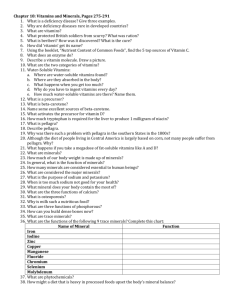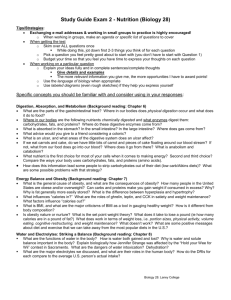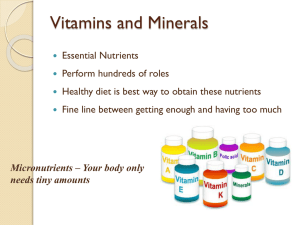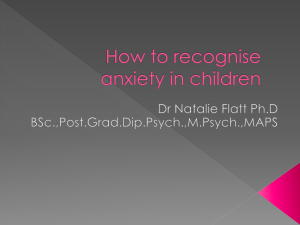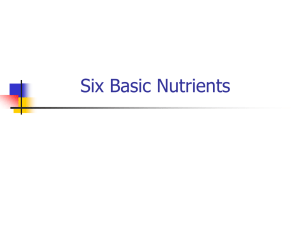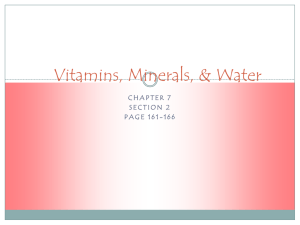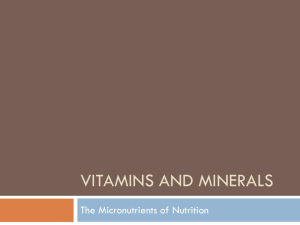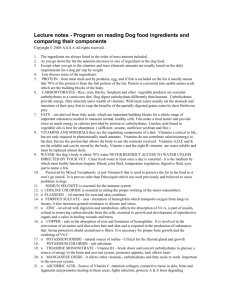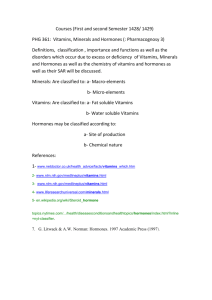Chapter 8: Vitamins and Minerals
advertisement
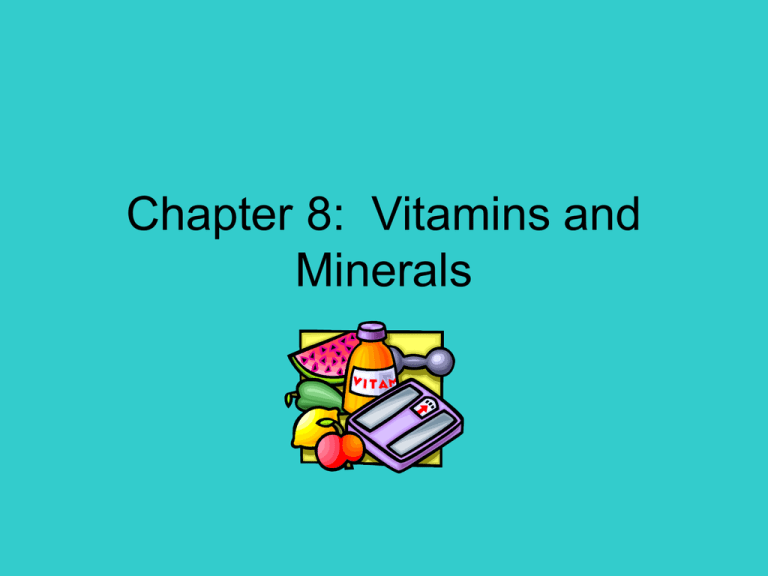
Chapter 8: Vitamins and Minerals Define the Following Terms: • 1. antioxidants—substances that protect body cells and the immune system from damage by harmful chemicals in air and foods. • 2. electrolyte minerals—sodium, chloride, and potassium, which control and balance fluid flow in and out of cells. • 3. fat-soluble vitamins—vitamins absorbed and transported by fat. • 4. free-radicals—harmful by-product excreted when cells burn oxygen to produce energy. • 5. hypertension—high-blood pressure linked to high salt intake. • 6. iron-deficiency anemia—lack of enough iron in the body, resulting in fatigue, weakness, and shortness of breath. • 7. major minerals—macrominerals with special duties in the body; calcium, phosphorus, magnesium, sodium, chloride, and potassium. • 8. osteomalacia—a disease caused by a lack of vitamin D in adults. • 9. osteoporosis—condition caused by calcium deficiency; bones become porous, weak, fragile. • 10. pica—Condition linked to iron deficiency; causes unusual appetite for ice, clay, and other nonfood items. • 11. toxicity—excessive amount of substance that reacts as poison in the body. • 12. trace minerals—minerals needed in only small amounts but serving vital body functions. • 13. water-soluble vitamins—vitamins dissolve in water and pass easily into the bloodstream during digestion. Answer the following questions: • 1. Why are vitamins and minerals called micronutrients? • They are needed in smaller amounts than other nutrients. 2. Why are some vitamins considered to be antioxidants? • They protect body cells and the immune system by either transforming harmful free radicals into less damaging compounds or repairing damaged cells. 3. Compare water-soluble and fatsoluble vitamins. • Water-soluble vitamins dissolve in water and are carried in the bloodstream; they are not stored, and excess amounts are eliminated with waste products. Fatsoluble vitamins are absorbed and transported by fat; excess amounts are stored by the body for later use. 4. What does vitamin C do for you? • Helps maintain healthy capillaries, bones, skin, and teeth. Helps your body heal wounds and resist infections. Aids in the absorption of iron and works as an antioxidant. Plays a role in caring for collagen that gives structure to bones, cartilage, muscle, and blood vessels. 5. One family stored milk in small, clear containers. What do you think of this practice? • Not good because light through the containers will destroy riboflavin in the milk. 6. What function in the body do riboflavin, niacin, vitamin B6, vitamin B12, vitamin B5, and biotin have in common? • They are all involved in using carbohydrates, proteins, and fats. 7. Why is folate a very important vitamin? • It helps the body use proteins, builds red blood cells, and forms genetic material. It prevents birth defects that damage the brain and spinal cord. 8. What can occur with vitamin A deficiency? • Rough, scaly skin and infections in the respiratory tract and other areas of the body; causes night blindness and total blindness in many children in developing countries. 9. What is toxicity? • An excessive amount of a substance that is poisonous in the body. 10. What are two ways to get vitamin D? • Through exposure to sunlight and in fortified milk. 11. Why do cooks need to pay particular attention to the ways that foods are prepared? • Some cooking techniques can destroy certain vitamins. 12. Compare major and trace minerals. • The amount of trace minerals the body needs is much smaller than the amount of major minerals needed. 13. Why do teens need to think about osteoporosis? • Bone mass builds u p during childhood, the teen years, and young adulthood, so care taken to consume calcium during early life can prevent the disease from developing later. 14. Why are sodium, chloride, and potassium called electrolyte minerals? • They form chemical particles called electrolytes, which attract fluids. Cells move electrolytes through cell walls as needed to balance fluids and keep cells from collapsing or bursting. 15. What can help reduce hypertension? • Lowering intake of table salt. 16. What are some signs of irondeficiency anemia? • Being tired, weak, short of breath, pale, and cold. 17. One teen chewed on ice to the point that her friends noticed and commented on the frequency. What might be wrong? • She might have pica, an unusual appetite for ice, clay, or other nonfood items, indicating an iron deficiency. 18. Why is fluoride needed in the diet? • To prevent tooth decay and strengthen bones. 19. What do you think about the trend to fortify many food products with vitamins and minerals? • Might help some people, but also has the potential to cause toxic excesses How does your diet rate? Balanced Diet = Good Health The End

